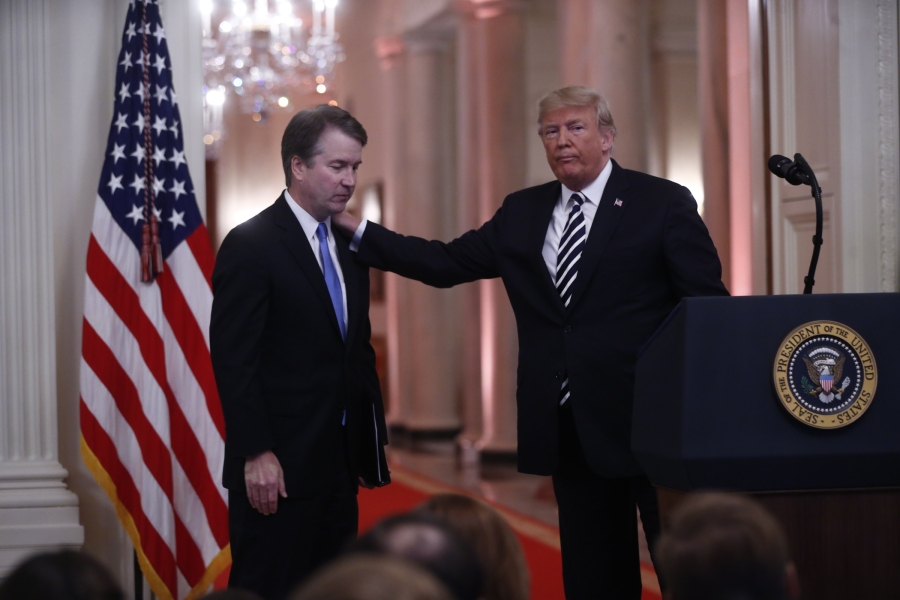
My more perceptive readers may have noticed that I’ve started referring to the justices of the Supreme Court as “Republicans” and “Democrats,” breaking with the traditional journalistic norm of labeling the justices “conservative” or “liberal.” In the interest of transparency, I want to explain why.
The short answer is that the words “Republican” and “Democrat” help convey what has happened to the Supreme Court in the last several decades. The Court has always been a political institution, but for most of its history there were not the hardline distinctions between justices chosen by a president of one political party, and justices chosen by the other party that we see today. As recently as 2010, for example, the Court included Justice John Paul Stevens, a Gerald Ford appointee who typically voted with the Court’s liberal wing.
SCOTUS, Explained
Get the latest developments on the US Supreme Court from senior correspondent Ian Millhiser.
Email (required)Sign UpBy submitting your email, you agree to our Terms and Privacy Notice. This site is protected by reCAPTCHA and the Google Privacy Policy and Terms of Service apply.
Gone as well are relatively moderate jurists like Justices Lewis Powell, Sandra Day O’Connor, and Anthony Kennedy. These were the sorts of justices who voted to limit abortion rights, but not to eliminate them. They placed strict restrictions on affirmative action, but didn’t kill it entirely.
Now, however, this kind of moderation is anathema, especially to Republican legal elites, many of whom still use the battle cry “No More Souters” to describe their approach to judicial appointments — a reference to Justice David Souter, a George H.W. Bush appointee who turned out to be a moderate liberal.
The Republican Party’s highest officials certainly haven’t behaved as if they think that justices are nonpartisan. Why else would Senate Republican Leader Mitch McConnell make up a fake rule to stop President Barack Obama from confirming a Supreme Court justice in the final year of his presidency? McConnell claimed that justices may not be confirmed in a presidential election year. Then he abandoned this fake rule four years later to place Trump appointee Amy Coney Barrett on the high court.
Nor have Democrats failed to police their own nominees’ ideological conformity. None of the Supreme Court justices appointed by presidents Bill Clinton, Barack Obama, or Joe Biden broke with the Democratic Party’s approach to judging in the same way that Souter broke from the GOP’s. All of them generally supported abortion rights, affirmative action, marriage equality, and the Affordable Care Act. Every Democrat on the Supreme Court opposed Donald Trump’s claim that he could commit crimes while he was in office. All of the Court’s Democrats oppose the Republican justices’ decisions giving themselves a veto power over any regulatory decision made by the executive branch.
The word “conservative,” which is typically used to signal caution or an allegiance to the status quo, is a particularly inappropriate term to describe this Court’s Republican majority. What, exactly, are the Republican justices “conserving” when they overrule multiple seminal precedents in a single term? What is “conservative” about abandoning the Court’s procedural norms to hand down revolutionary new legal rules on the Court’s shadow docket? What is “conservative” about rushing out half-baked legal standards that are incomprehensible to lower court judges?
I am a journalist. That means it is my job to convey truth to my readers, and to describe the Court that I cover as accurately as I possibly can. And the unfortunate truth is that the Supreme Court of the United States is now a partisan institution. I would do my readers a disservice if I covered up this reality. Or if I used euphemistic language like “conservatives” and “liberals” to describe fundamentally partisan political appointees.
And so I will not. And I encourage other journalists to do the same.
The Supreme Court only recently became a partisan institution
It’s astonishing how little thought many past presidents put into their Supreme Court appointments. In the past, justices were often chosen for idiosyncratic personal reasons, or to please a particular interest group or voting bloc, and without much, if any, inquiry into how the nominee was likely to decide cases.
President Woodrow Wilson, for example, appointed Justice James Clark McReynolds — an awful judge and an even worse human being who Time magazine once described as a “savagely sarcastic, incredibly reactionary Puritan anti-Semite” — in large part because Wilson found McReynolds, who was US attorney general before he joined the Court, to be so obnoxious that the president promoted him to get him out of the Cabinet.
Similarly, President Dwight Eisenhower complained late in his presidency that appointing Justice William Brennan, one of the most consequential left-liberal jurists in American history, to the Supreme Court was among the biggest mistakes he made in office. But Ike’s White House never vetted Brennan for his ideological views, and Brennan was selected largely because Eisenhower was running for reelection when he made the nomination, and he thought that appointing a Catholic like Brennan would appeal to Catholic voters.
Even in 1990, after top Republican officials had published lengthy documents laying out their party’s vision for the Constitution, they still hadn’t developed a reliable system for vetting Supreme Court nominees to ensure that they were on board with the party’s agenda. Bush chose the center-left Justice Souter over other, more right-wing candidates largely due to misguided advice from his top legal advisers.
As journalist Jan Crawford Greenburg reported in a 2007 book, Souter beat out early frontrunner Ken Starr — the same Ken Starr who would go on to hound President Bill Clinton in the Monica Lewinsky investigation — in large part because Bush’s right-wing advisers feared that Starr was too liberal. According to Crawford Greenburg, then-Deputy Attorney General Bill Barr opposed Starr because of a low-stakes dispute over “a federal law that permitted private citizens to sue for fraud against the federal government.”
Much has changed since 1990. On the Republican side, the Federalist Society — a kind of bar association for right-wing lawyers with chapters on most law school campuses and in most major cities — now starts vetting law students for elite legal jobs almost as soon as they begin their studies. And Republican presidents can rely on the Federalist Society to identify ideologically reliable candidates for the bench. As Trump said in 2016 while campaigning for president, “We’re going to have great judges, conservative, all picked by the Federalist Society.”
Nor is the Federalist Society the only way Republicans vet potential Supreme Court nominees. Every single one of the Court’s current Republican members except for Barrett previously served as a political appointee in a GOP administration, roles that allowed high-level Republicans to observe their work and probe their views.
Democrats’ vetting process, meanwhile, is more informal. But it’s been no less successful in identifying Supreme Court nominees who reliably embrace their party’s stance on the most contentious issues. The last Democrat appointed to the Supreme Court who broke with the party’s pro-abortion rights stance, for example, was Justice Byron White — a dissenter in Roe v. Wade appointed by President John F. Kennedy in 1962.
The result is a modern-day Supreme Court where every single member was carefully selected by their party to ensure that they will not stray on any of the issues where the two parties have settled views. Every Republican justice voted to abolish affirmative action on nearly all university campuses, with every Democratic justice in dissent. Every Republican voted to give the leader of the Republican Party broad immunity from criminal prosecution, with every Democrat in dissent. Every Republican except for Roberts voted to overrule Roe (and Roberts merely argued that the Court should have waited a little longer), while every Democrat dissented.
The arguments against treating the justices as partisan actors are unpersuasive
So, with all this evidence that the Supreme Court has become no less partisan than Congress or the presidency, what are the arguments against speaking of the justices in the same way we speak of presidents or members of Congress?
Let’s start with the worst — albeit fairly common — argument for labeling the justices as nonpartisan actors: the claim that the justices are merely carrying out a particular “judicial philosophy” when they make decisions, and not making decisions based on what outcome their political party would prefer.
As a descriptive matter, it’s probably true that most of the justices imagine themselves as devotees to a particular philosophy of judging, rather than as partisans carrying out a predetermined agenda. The six Republican justices who ruled that Trump was allowed to do crimes while he was in office, for example, would probably claim that they were applying a legal theory known as the “unitary executive” when they ruled in Trump’s favor — and not that they were reflexively protecting their own party leader.
But this distinction is entirely academic, and it says nothing about how judges actually behave on the bench. As a practical matter, the difference between a hypothetical justice who consistently votes for the Republican Party’s preferred outcomes because they’ve adopted a “judicial philosophy” that reliably leads to those outcomes (we’ll call this hypothetical justice “Clarence Thomas”), and a hypothetical justice who votes for the same outcomes because they are a party loyalist (we’ll call this hypothetical justice “Samuel Alito”), is nonexistent.
A slightly more sophisticated rebuttal is that the Court’s Republicans often vote with the Court’s Democrats. This is especially true in cases that do not raise politically contentious issues, but it also occasionally happens in cases involving divisive issues such as abortion. As Sarah Isgur and Dean Jens argue in an early June article making this claim, in the Court’s 2022-23 term, “about 50 percent of the court’s cases were decided unanimously.”
It is true that the Court still hears a decent share of cases involving technical legal questions — such as when someone seeking certain veterans benefits should file a particular form, or when certain bankruptcy cases may be appealed — that do not divide the justices along partisan lines. But the same can be said about the other branches of government.
In the month of July alone, for example, Congress enacted, and President Joe Biden signed, 13 new laws. None of these laws divided the two parties, and all of them were passed overwhelmingly — in some cases by a voice vote or by unanimous consent. Yet political reporters have no problem with labeling members of Congress “Democrats” or “Republicans” even though those members frequently agree about which bills should become law.
Similarly, if you look at the schedule of, say, Florida Gov. Ron DeSantis, a Republican, you will find that it is dominated by the sort of ordinary governance issues that come before governors of either party. DeSantis recently awarded an $8 million grant to help build roads in a Miami park, for example. And he touted the fact that emergency responders in Florida “pumped more than 194 million gallons of floodwaters” from Florida communities hit by Hurricane Debby.
It’s likely that, if Florida’s governor was a Democrat, the state would have had a similar response to a hurricane. But the fact that DeSantis frequently oversees nonpartisan activity does not make him any less of a Republican.
It’s also true that the Supreme Court, despite its Republican majority, sometimes reverses lower court decisions that would have moved the law aggressively rightward. In its most recent term, the justices reversed several fairly extreme decisions from the far-right United States Court of Appeals for the Fifth Circuit, including one that could have triggered a second Great Depression.
But, again, the fact that the Republican justices do not always take maximally right-wing views does not make them less Republican. Nor does it distinguish them from Republicans in other parts of the government. Many GOP members of Congress, for example, oppose providing military aid to Ukraine. But, when a Ukraine aid bill finally reached the House and Senate floors this spring, it was supported by 101 Republican House members and 31 Republican senators.
Similarly, in 2023, DeSantis proposed unconstitutional legislation that would have limited press freedom in the state of Florida. Yet, while some Florida Republicans backed DeSantis, the bill died after conservative media organizations lobbied Republican lawmakers, warning them that the bill might hurt right-wing outlets.
It is entirely normal, in other words, for Republican officials to disagree about specific issues, even if they share a partisan identity and a general approach to governance. The fact that the Republican justices also sometimes disagree with each other, or with more extreme Republicans elsewhere in the judiciary, does not make them any less Republican.
The Republican justices, in other words, behave just like Republicans in other policymaking roles. They sometimes disagree with their fellow Republicans on important issues, but they also share a broad theory of governance, as well as a fairly granular agenda that includes (among other things) eliminating the constitutional right to an abortion, implementing a “colorblind” theory of the Constitution, and centralizing regulatory authority in the judicial branch of government.
This shared agenda, moreover, did not happen by coincidence. It happened because Republicans developed a coherent view of the Constitution and the role of the judiciary, and then built sophisticated institutions to ensure that their judicial appointees share this view.
Journalists do not hesitate to label, say, former Attorney General Bill Barr a “Republican” just because he was appointed to high office and not elected, and we should not treat the political appointees on the Supreme Court any differently. We should call the Republican justices “Republicans,” and the Democratic justices “Democrats,” because that is the best way to educate our readers about how the modern-day Supreme Court actually functions.
Source: vox.com






